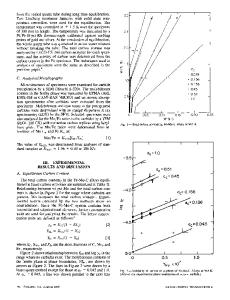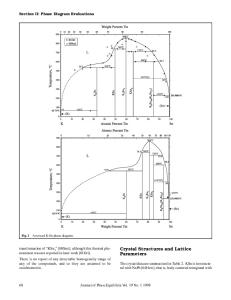Thermodynamics of the system iron-aluminum-oxygen between 1073 K and 1573 K
- PDF / 1,391,708 Bytes
- 9 Pages / 603.28 x 783.28 pts Page_size
- 88 Downloads / 326 Views
I.
INTRODUCTION
P H A S E relations in the Fe-A1-O system at temperatures in the range 773 K to 2023 K have been studied by several investigators. 1-14 The stabilities o f the oxide phases coexisting with each other or with the metal phase at temperatures higher than 1273 K were discussed and represented in equilibrium oxygen pressure diagrams at 1553, 1653, and 1773 K. 13 In this investigation, the equilibrium oxygen pressure of several ternary univariant coexistences in the Fe-A1-O system are determined between 1123 K and 1423 K using galvanic cells with calcia stabilized zirconia as electrolyte. The dissociation pressures of a-alumina coexisting with the alloys were calculated using the aluminum activity data for the binary Fe-A1 alloys) 5'16 The oxygen pressure data in conjunction with compositions of the oxide and metallic phases obtained in this investigation using electron probe microanalyses and from various literature sources were utilized to construct equilibrium oxygen pressure diagrams at 1073, 1173, and 1273 K.
II.
EXPERIMENTAL
Equilibrium oxygen pressures of three univariant ternary coexistences at temperatures between 1123 K and 1423 K were determined from electromotive force (emf) measurements on the following cells: Fe,FeO[ZrOz(+CaO)lhematite, spinel, alumina (A) alloy, wustite, spinellZrOz(+CaO)[Fe,FeO (B) alloy, spinel, aluminalZrO2(+CaO)lFe,FeO (C) Alumina,* hematite, and wustite in the above cell compart*Alumina is used in the subsequent text to indicate a-alumina.
ments refer to the ternary oxides (A1Fe)203, (FeA1)203, and (FeA1)O. Alloy refers to the Fe-A1 alloy which is essentially pure iron when equilibrated with the ternary coexistences of cells (B) and (C). Magnetite, Fe304, is an inverse spinel, and hercynite, FeA1204, has a normal spinel structure] 4
F. A. ELREFAIE, formerly with McMaster University, is now Assistant Professor, Department of Metallurgical Engineering, Cairo University, El Giza, Egypt. W.W. SMELTZER is Professor, Department of Metallurgy and Materials Science, McMaster University, Hamilton, Ontario, Canada, L8S 4M1. Manuscript submitted November 10, 1981. METALLURGICAL TRANSACTIONS B
These two spinels, however, exhibit mutual solubilities and become completely miscible at temperatures higher than 1133 • 15 K. n The cells and the cell assembly which contained a 30 cm long calcia stabilized zirconia tube, 0.85ZRO2 9 0.15CaO, were identical to the designs previously described] 7 A cell was evacuated initially to < 1 0 -3 torr and flushed with purified argon at room temperature, 200 ~ 400 ~ and finally at 1150 ~ The cell was then left at this temperature for three to four hours to allow stabilization. The steady potentials obtained, within • mV, were recorded for periods between 45 and 60 minutes at each temperature before changing the cell to another temperature. The emfs were measured between 1123 K and 1423 K at 50 ~ intervals for both increasing and decreasing temperature. Reversibility of a cell was checked by momentarily discharging it through an extemal circui
Data Loading...











